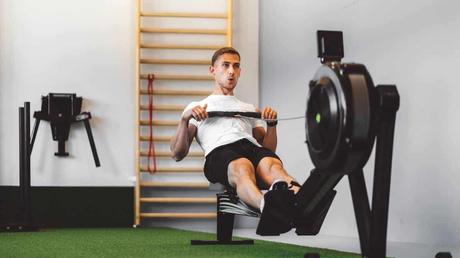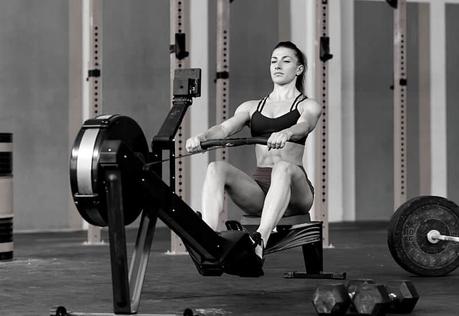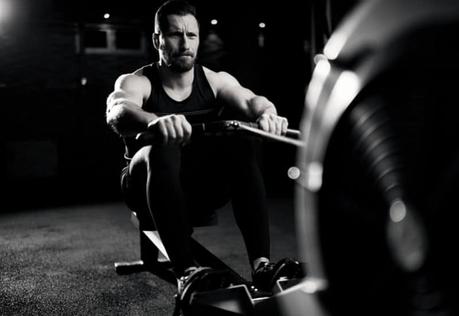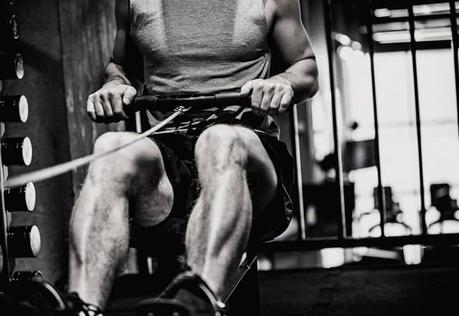Ready to tackle the rowing machine for your next workout? Here’s everything you need to know about how to use it like a pro, including some common mistakes people make on the rower.

Rowing machines are one of my favorite cardio machines in the gym, not just for weight loss and fat burning, but for building power and improving back and trunk strength.
But while there are a ton of benefits of the rowing machine, they are all predicated on using the rowing machine properly.
That’s what we are going to cover in this article.
How to use the rowing machine properly (aka safely) and effectively. Some technique tips for mastering form. And cover some common technique mistakes people make on the rower.
Let’s jump right in.
Why the Rowing Machine is so Awesome
Let’s start off with why I love the rowing machine, and why it’s worth learning about how to use it properly right off the bat.
Here are the “Big Four” benefits of the rowing machine:
 Benefit #1: Full Body Workout
Benefit #1: Full Body Workout

If you take a look at list of muscles worked on the rowing machine, you’ll see that it’s pretty much all of them getting involved with the rowing movement.
- When you drive backward and pull forward with your legs, your quads, hamstrings, glutes, and calves all engage.
- When you lean your torso backward and forward in tandem with your legs and arms, your abs, lower back, and hips all engage.
- When you pull the handle to your torso to complete the rowing stroke, your upper back, shoulders, biceps, and forearms all engage.
Really the only muscles that don’t work are your chest and triceps muscles (which are there to “push” rather than “pull”).
Otherwise, your entire body works together to move through each rowing stroke.
 Benefit #2: Makes HIIT Training Easy
Benefit #2: Makes HIIT Training Easy

HIIT is one of my favorite forms of training. It’s a blend of maximal effort with minimal time. The ultimate 1-2 punch when working out, IMO.
Basically, with HIIT, you spend short periods of time training at max intensity, with just enough low-intensity training between to allow for recovery without dropping your heart rate.
Asa result, you can get in a highly effective (both in terms of muscle-building and fat-burning) workout in a fraction of the time.
Some cardio machines come with pre-sets that make it easy to switch between high intensity and low intensity intervals.

For example, the exercise bike with its pre-programmed “routes”, or the elliptical with its preset HIIT workouts.
Other machines, however, make it more difficult to switch between high and low intensity intervals. The treadmill is one such. To push into the realm of high intensity effort, you have to manually raise the speed until you’re sprinting. Then, you have to again manually lower the speed to return to low-intensity walking or jogging.
With rowing machine HIIT workouts, there’s no fiddling with any buttons or worrying about any pre-sets (or the lack thereof).
All you have to do to push from low intensity to high intensity is to row faster, and to reverse it (from high to low intensity), just slow down your rowing pace.
I’m all about any machine that delivers maximum results with the least amount of fiddling and pressing buttons!
 Benefit #3: Surprisingly Joint-Friendly
Benefit #3: Surprisingly Joint-Friendly

No matter what type of rowing machine you use, you’ll find that you can get a pretty great full-body workout (as we saw above) that engages multiple muscle groups and all the joints in your body.
Rowing is a workout that helps to increase mobility by forcing your joints to move repeatedly through a full range of motion. The more you row, the less likely you’ll be to experience stiffness or limited mobility in your hips, ankles, knees, lower back, shoulders, elbows, and wrists.
But what makes rowing really great for your joints is the fact that there’s zero impact. There is no lifting your feet and placing them down again (like when you step), but your feet are planted and it’s the seat that does all the moving (sliding back and forward).
Rowing is a very low-risk, low-impact form of exercise that anyone can do safely. It’s even a great form of rehab that can help you recover from injury or surgery.
Trainer’s Note: Although the rowing machine is a low impact cardio machine, it’s not an ideal for people with injured lower backs. The rower places additional stress on this part of the body, so it’s best to avoid until recovered.
 Benefit #4: Burns A LOT of Calories
Benefit #4: Burns A LOT of Calories

If you compare the calories burned on the row machine to most of the other cardio machines in the gym, you’ll see that the rowing machine is a certified gangster for lighting calories on fire.
According to Harvard Medical School1:
- Moderate calisthenics will burn between 135 and 189 calories in 30 minutes
- Weightlifting will burn between 180 and 252 calories in 30 minutes
- High impact aerobics will burn between 210 and 294 calories in 30 minutes
- A vigorous rowing workout will burn between 255 and 440 calories in 30 minutes
Quite the advantage, isn’t it?
There are some workouts that will burn as much or more—for example, elliptical training, sprint training, or training on the assault bike).
However, thanks to the fact that rowing engages your entire body, it will burn more calories than the majority of the cardio workouts around.
How to Use the Rowing Machine Like a Pro
If you’re new to the rowing machine, it’s worth putting in some time and practice to master the form and posture.
Trainer’s Note: Posture = static. Form = in motion.
Both are actually surprisingly simple to get right; once you understand how you should be moving, it shouldn’t be too much work to put it all together for smoother, more efficient rowing.
When rowing, there are four basic stages you need to know:
Stage 1: The Catch.
This is when you’re slid as far forward as you can go, getting ready to pull backward on the handle.
Your arms will be fully extended, your feet planted against the pedals, and your shins as close to vertical with the floor as possible. Your upper body will have a slight forward lean (think 11 o’clock), too.
Stage 2: The Drive.
This is where things get explosive and your body really gets to work. This phase starts when you engage your core to maintain a stable upper body while your legs begin to push (drive) against the pedals.
As your legs extend and your seat slides backward, begin leaning backward, shifting from 11 o’clock to end up in the 1 o’clock position. Your arms will also pull the handle toward your torso.

Stage 3: The Finish.
If you performed the drive correctly, your legs will reach full extension, the rowing handle will tap against your belly, and your upper body will reach the 1 o’clock position (with a slight backward lean) all at the same time—at the end of the drive, also known as the “Finish”.
Stage 4: The Recovery (or Return).
This is the part of the stroke when you return to your starting position (The Catch) and get ready to do it all over again.
With the Drive, you moved your legs first, then your hips hinged to move your upper body backward, and finally your arms pulled on the handle.
With the Recovery, you do it in reverse: your arms start extending to return the handle to its starting position, your hips hinge to move your upper body forward, and at last your legs bend to slide you forward.
You should reach the starting position (the Catch) with your arms fully extended, your knees bent, and upper body leaning slightly forward.
As I said, it takes a bit of practice, but you’ll find it’s actually fairly easy to get it right.
Just keep in mind the proper sequence of movements:
- The Drive = legs > hips/torso > arms,
- The Recovery = arms > hips/torso > legs
Common Mistakes People Make When Using the Rowing Machine
Even though the row machine looks blisteringly simple—pull handle, recover—there are some key mistakes I see trainees make when grinding out the meters on a rower.
The big ones include:
 Not breathing.
Not breathing.

Proper breathing is crucial for any cardio workout—be it running, rowing, or elliptical training—because it helps your body settle into a rhythm, facilitates the activation of fat to use as energy, and keeps you from fatiguing too quickly.
For rowing:
- Take one breath per stroke.This is great for low-intensity rowing, because you’ve got plenty of time to inhale during the recovery and exhale during the drive.
- Take two breaths per stroke. This is better for high-intensity rowing, when your body is in need of more oxygen but you don’t have as much time for drawn-out inhalations and exhalations. Exhale with the drive, inhale and exhale during the recovery, and take your last inhalation when you hit the catch.
Test both breathing patterns out to find which works best for you and keeps you on track with your rowing.
Try to match the breath to the stroke as much as possible.

 Hunching.
Hunching.

Hunching your shoulders means your upper back is less engaged, your neck hangs forward (leading to strain), and your shoulders end up doing more of the work than they should be. Plus, hunching also risks injuring your lower back, too.
Remember: it’s your upper back that should be doing the pulling, with the shoulders acting as secondary support muscles. Keep your back straight and shoulders back.
 Dropping your knees to the side.
Dropping your knees to the side.

This is a HUGE mistake that will decrease the effectiveness of the rowing workout for your legs.
Typically, you only let this happen (your bent knees flop outward) because your inner thigh and hip flexor muscles aren’t strong enough to maintain the rowing stroke.
Make sure your knees stay in line with your hips so your quads, glutes, and hamstrings do as much of the work as possible.
 Raising your arms too high.
Raising your arms too high.

There are two ways this can happen:
- When you’re pulling into the drive. If you bring the handle up to your chest or chin, you’re lifting too high and risk straining your shoulders and wrists. The handle should come straight toward your solar plexus.
- During the “Recovery” phase. Typically, you do this because raising the handle (in a scooping motion) is the only way to extend your arms fully when your knees are bent. But what this means is that you’re not going through the motion correctly. You should extend your arms, lean forward slightly, and only then bend your knees to slide forward.
These are the four most common mistakes you can make when rowing, but correcting them with go a long way toward making you a more efficient—and effective—rower!
How to Use the Rowing Machine — FAQs
How long should beginners use a rowing machine?
Ideally, your “target” workout should be 30 minutes. If you can’t hit 30 minutes right off the bat, don’t worry!
Beginners, shoot for either 10 minutes or 2 KM. Once you can hit either of those milestones, keep adding—another 5-10 minutes or 1-2 KM.
Add more time and/or distance to your workout every workout, until you can hit that 30-minute goal (and, ideally, at least 6 KM rowing distance in that time).
Can you get in shape by just rowing?
You can—sort of.
Rowing is all about cardio, meaning it increases your cardiovascular endurance (in your lungs, heart, and blood vessels). It will build some minor muscular endurance, but really it’s about cardio and fat-burning.
You can lose a bit of weight and get in better shape in terms of cardiovascular endurance, but you won’t see gains in your strength or flexibility.
To be properly fit, you have to take into account all four pillars of fitness: muscular strength, muscular endurance, cardiovascular endurance, and flexibility/mobility.
That’s why I recommend you mix it up! Keep rowing a few times a week, but mix in a few weight training sessions, a Yoga class or two, and plenty of high-intensity interval training to push your fitness overall to its limits.
The Bottom Line
Rowing can be a truly enjoyable workout, one that does wonders to improve your cardiovascular conditioning and help you burn fat.
The fact that it targets so many of your muscles—pretty much all of them—makes it excellent for building some muscular endurance, as well as keeping your body mobile and able to move freely.
Thanks to the advice above, you can make each rowing workout count and avoid the newbie mistakes that could make your rowing less effective.
Happy training!
More Rowing Machine Guides and Articles
Do Rowing Machines Build Muscle? (Yes, Here is How). The rowing machine is a killer cardio machine that can also help you build muscle… if done properly. Learn how to use the row machine for building muscle and try three of our favorite muscle-building workouts.
The Different Types of Rowing Machines (Pros and Cons of Each). Wondering what type of rowing machine is right for you? From low impact to high intensity, here’s a look at the different types of rowing machines.
